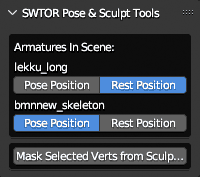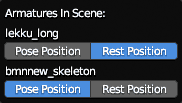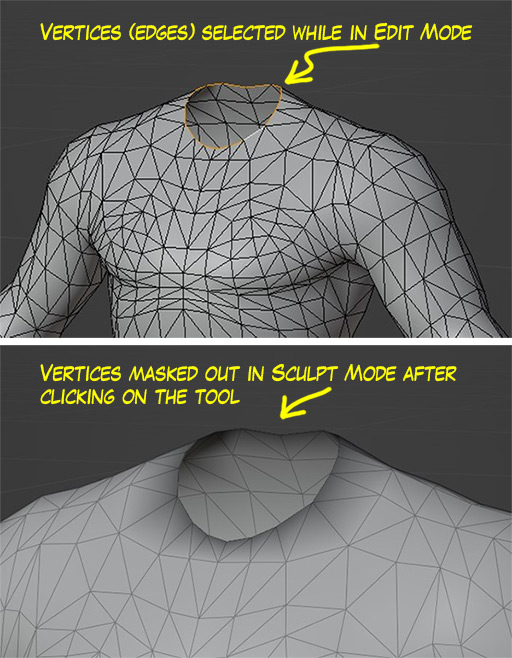ZG SWTOR Pose and Sculpt Tools - SWTOR-Slicers/WikiPedia GitHub Wiki
(Back to ZG SWTOR Tools Add-on's index)
This panel holds minor tools having to do with posing or sculpting. Some of them SWTOR-specific, some simply a few already existing Blender tools that are a little too buried inside their panels or require several steps that would be nice to have more at hand. We'll see what else we can come up with.

- Armatures In Scene's Pose/Rest Position.
- Clear Bones' Translations.
- Mask Selected Vertices From Sculpting.
Armatures In Scene's Pose/Rest Position.

Requirements.
- The presence of armatures in the scene.
It shows the Pose Position and Rest Position buttons of all the armatures (skeletons) in the scene without the need to select them one by one to make their individual pose/rest settings show up in the Properties panel.
Clear Bones' Translations.

Requirements.
- A SWTOR armature ("Skeletons").
Clears all translation data from all bones in an armature and, if animated, all the keyframes' translations, leaving the rotation and scaling data intact. it's meant to correct imperfections in imported animations that distort characters' bodies (they might need manual adjustments afterwards, to compensate for what the translations added to the poses).
It doesn't affect the GrannyRootBone, Master, Bip01, Root and RootSpine bones that contribute to major movements across the stage.
In the following image we can see the results of loading a problematic animation to a Body Type 2 female: the bones have moved so much that the body and limbs are severely elongated. By deleting the translation data, we recover the original proportions of the character, if the pose has been left somewhat altered and will need readjusting:

Mask Selected Vertices From Sculpting.

Requirements.
- An active selection of vertices set while in Edit Mode. The button is meant to be clicked while in Sculpt Mode, though.
This is a tool that maybe doesn't need to exist, as Blender might offer a better way to do it already. Still… The way it works is based on the fact that if you do a selection of vertices while in Edit Mode, that selection persists after switching to Sculpt Mode (and others).
What this tool does is inverse-mask those vertices (that is, mask everything else) so that they are protected from any sculpting tool's brushstrokes.

The motivation behind this was to be able to deform characters' objects (say, swole up a SWTOR Body Type 2 (bmn or bfn) to a BT 2.5 of sorts, or change their facial features) without affecting crucial areas such as the torso-to-head neck or other body parts' seams' matching vertices, or the eyelids and mouth's edges.
Normally, we might fuse the body parts into a single mesh and don't care about the seams anymore, but we might want, for example, to make a reusable modified torso part whose neck base's edge still fits all head objects' necks.
By selecting the relevant vertices in Edit Mode (even maybe saving them as a vertex group for easy recall), we can quickly protect or unprotect them at the press of a button while in Sculpt Mode.